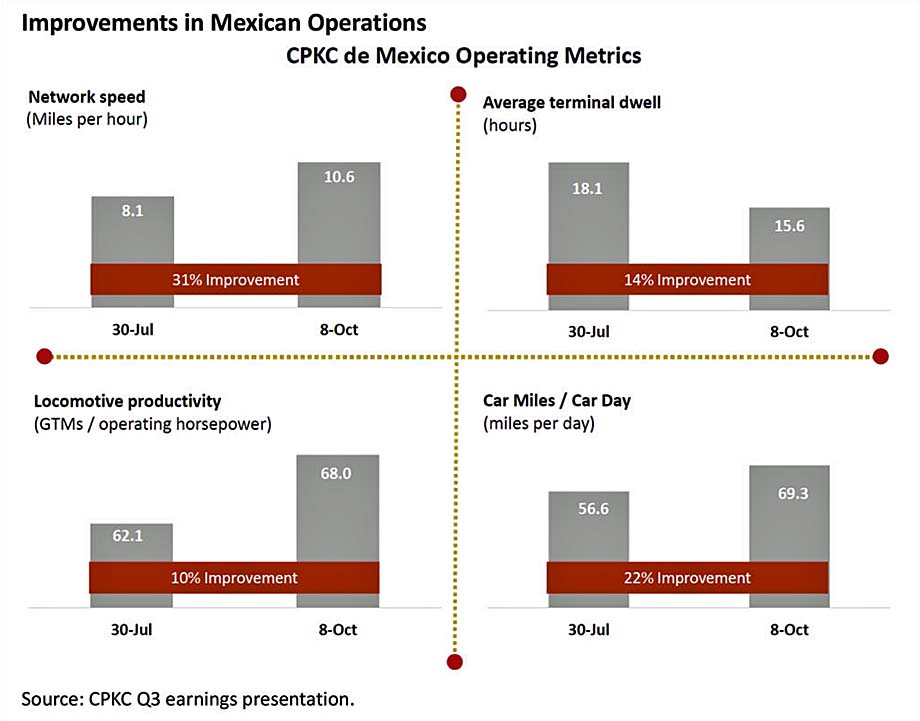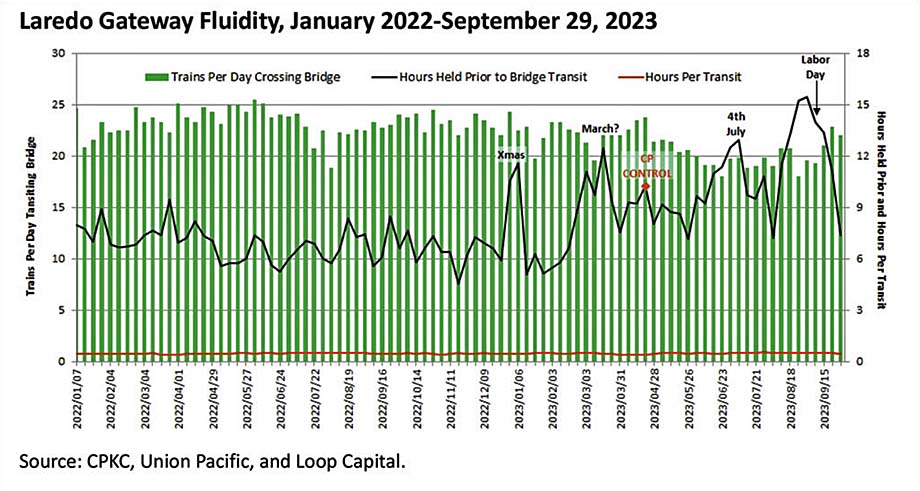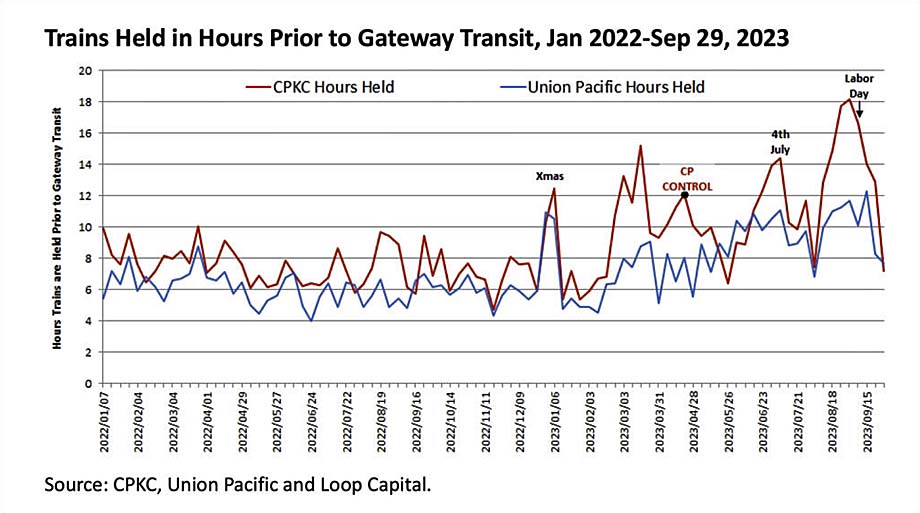
New York New York USA
North America - Last week we highlighted a big drop in terminal dwell in Mexico as evidence that
CPKC's broader Mexican operation is finally turning around, after a year in the doldrums.
Our 23 Oct 2023 report came with some caveats, including the fact that it was just one week's worth of
data.
We've since got a second week, which largely reinforces the new trend.
Terminal dwell at Sanchez Yard, near the border, fell again from 27 to 23.5 hours and is now below its three-year
trailing average of 24.7.
Monterrey deteriorated a little, from 30.4 to 33 hours (vs. a trailing average of 30.4, so not terrible) and San Luis
Potosi deteriorated from 6 to 8.8 hours.
Remember, CPKC includes run-through trains in its dwell calculations, which are trains that don't perform any work in
yards, they only change crews.
San Luis Potosi has a lot of run-through trains, which renders this somewhat of a junk metric (the STB standard is to
exclude run-through trains).
As usual, our chart shows a simple average of the three yards.
What we don't want to see is a reversion to above 25 hours.
Ideally, it will be below 20 hours in the near term.
Readers who didn't see our report last week still got the good news from the horse's mouth when CPKC highlighted
improvements in Mexico during its third-quarter earnings presentation.
Above is the slide with some details.
Also look at the label at the top of the slide, "CPKC de Mexico".
So it's CPKCM now rather than KCSM?
Doesn't quite roll off the tongue.
Laredo Bridge/Gateway Efficiency Part II
Last week we also began analyzing the fluidity of the industry's most important international gateway, Laredo, and we
showed the chart below.

It details how many trains per day typically transit the gateway (low-20s), how long it takes to move over the
gateway once trains have the green light (~29 minutes) and, most important, how long trains are held waiting to
transit.
That's the black line in the chart and most interesting piece.
We often hear the railroads tout faster times through the gateway relative to trucks that must queue for hours, but if
the railroads are doing the same thing, that advantage goes away.
All the data in the chart reflects the consolidated activities of CPKC (43 percent of bridge transits over the past 12
months) and Union Pacific (57 percent).
Last week we also said we've disaggregated the trains held data to show CPKC and Union Pacific separately, and here's
that chart:

CPKC: For CPKC through trains in the United States heading south toward the Laredo Bridge, CPKC
identified those trains that operated between Robstown and Mexico during the Reporting Week and performed no scheduled
work in the Laredo Terminal, and then, using available AEI reader data, measured the total time each train spent
between arrival at the boundary of the Laredo Terminal and the north end of the Laredo Bridge (AEI reader
605).
The terminal boundary for this purpose is the east end of CPKC's Laredo Yard (AEI reader 713).
For through trains in Mexico heading north towards the Laredo Bridge (and delivery to UP or KCSR), CPKC identified
those trains that operated between Mexico and the United States during the Reporting Week and performed no scheduled
work in the Laredo Terminal, and then, using available AEI reader data, measured the total time spent between arrival
at the boundary of the Laredo Terminal and the south end of the Laredo Bridge (AEI reader 861).
The terminal boundary for this purpose is the south/west end of KCSM's Sanchez Yard in Mexico (AEI reader
886).
Union Pacific: For UP trains heading south toward the Laredo Bridge, CPKC identified those UP trains that
operated between San Antonio, or UP's Port Laredo Intermodal Yard, and Mexico during the Reporting Week and performed
no scheduled work in the Laredo Terminal, and then, using available AEI reader data, measured the total time spent
between arrival at the boundary of the Laredo Terminal and the north end of the Laredo Bridge (UP AEI reader
605).
The terminal boundary for this purpose is the UP-operated AEI reader at a point named "Milo" (AEI reader
650), between UP's Port Laredo Yard and UP's Import Yard just north of the Bridge.
In terms of takeaways, both railroads were fairly consistent through January 2023 (ignoring the seasonal Christmas
bump), with CPKC and UP typically holding trains for seven and six hours, respectively.
So there's our first takeaway, even during UP's meltdown in 2022, its dwell prior to moving over the Laredo bridge was
not visibly impacted.
Beginning in February it all starts to go wrong, with CPKC trains experiencing some dramatic volatility and the delta
between CPKC and UP growing.
Union Pacific deteriorated to a lesser degree, but we can't know if this was self-inflicted or a domino effect from
CPKC's problems.
There are no doubt other nuances we're too far removed to see.
The available data runs through 29 Sep 2023, and as we've highlighted over the last two weeks, CPKC is finally getting
its arms around the Mexican operation, so presumably the fluidity across the Laredo bridge has also improved between
then and now.
We'll update the chart when CPKC makes its next data filing.
Rick Paterson.
(likely no image with original article)
(usually because it's been seen before)
provisions in Section 29 of the
Canadian Copyright Modernization Act.
